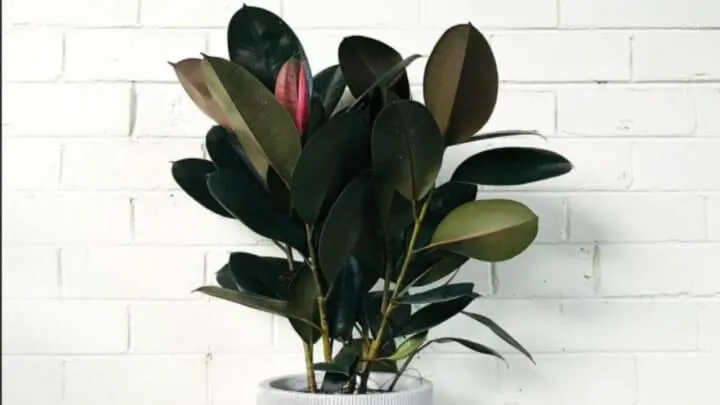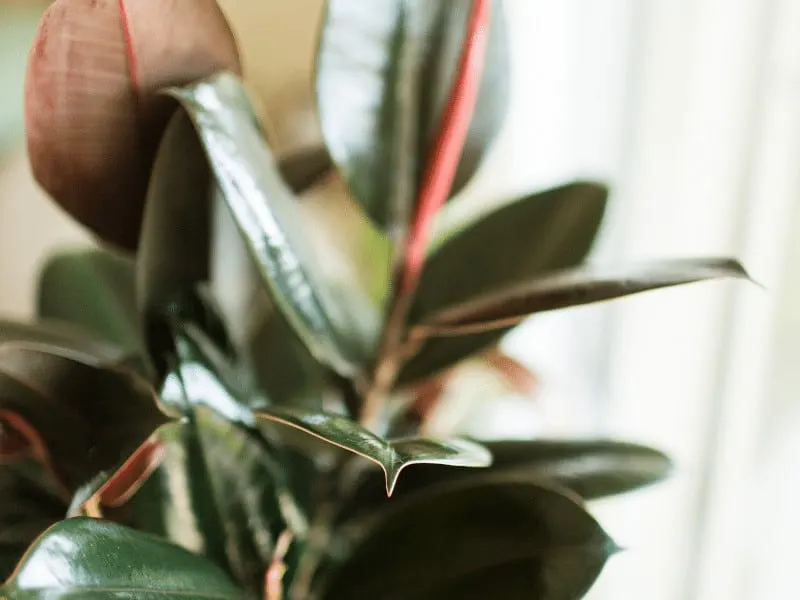Belonging to the family of Ficus elastica, the Burgundy Rubber Plant or Ficus elastica Burgundy, commonly known as Variegated Rubber Plant is easy to grow, care for, and propagate.
The botanical name of this plant is Ficus Elastica (the word ‘elastica’ referring to its elastic nature and uses).
The Burgundy Rubber Plant is native to Southern Asia and found in some neighboring countries as well. When placed in the open air from the start, this plant can reach a height of about 100 feet (30 meters).
However, when kept inside the house, it can grow up to 6-10 feet (1.8-3.0m).
Let’s dive into how I care for my Burgundy Rubber Plant indoors.
Burgundy Rubber Plant Care
Burgundy Rubber Plants thrive in bright indirect sunlight. Place them in an area with temperatures between 65-78 degrees Fahrenheit (18-26 degrees Celsius), and water when the soil’s top 3 inches are dry. (7.6cm) A humidity of 50% or more is perfect for burgundy rubber plants. Provide this plant with a soil mix containing parts of peat moss, perlite, and pine bark.

Burgundy Rubber Plant Care
Table of Contents
Burgundy Rubber Plant Care
1. Light
Although the burgundy rubber plant can survive in the bright direct light of the sun, it is best to keep it under shaded light to prevent discoloration of the leaves.
The equivalent at home is bright indirect light from an eastern or western-facing window.
Otherwise, the soft velvety texture of the leaves will soon be burnt, and you will be left with crisp and weakened discolored leaves.
Inappropriate light to this plant also is another cause for the yellowing of its leaves.
To provide the best light conditions for your plant, choose a spot in your living room and place the plant under a window facing in the eastern direction.
2. Soil
The best potting mix for your burgundy rubber plant can be made at home by mixing one part each of peat moss, perlite, and pine bark.
However, if you want to use a store-bought one, go for the potting mix that offers the best aeration.
3. Humidity
A humidity of 50% or more is perfect for burgundy rubber plants.
There is no limit when it comes to humidity requirements for these plants.
All species of rubber plants thrive greatly on humidity, and therefore, you do not need to worry about limiting the humidity level in your space.
It is wise to invest in a good humidifier to balance the humidity for your plant.
You can also mist the plant regularly so that they have enough moisture and growth is not stunned.
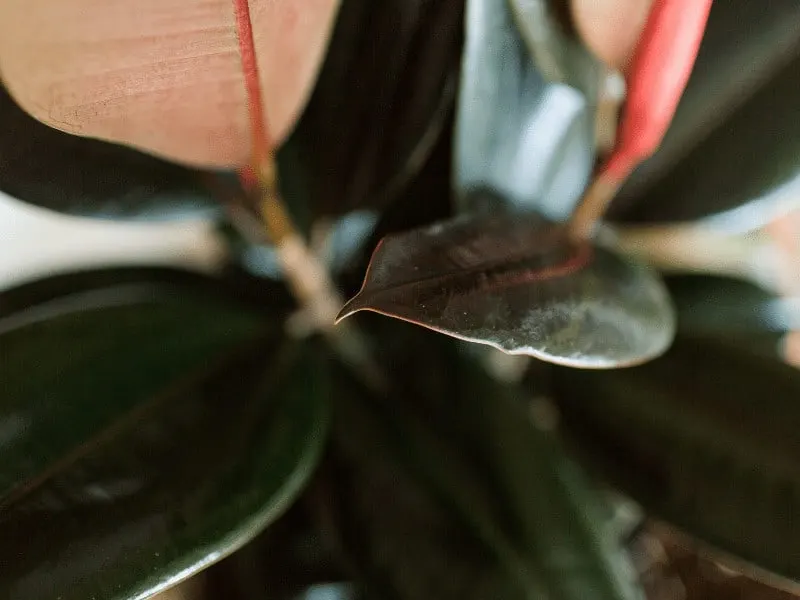
Ficus elastica Burgundy has dark shiny foliage
4. Water
The burgundy rubber plant is very susceptible to soggy soil in the bottom of the pot, which later causes rotting roots.
This can be extremely bad as rotten roots will eventually deteriorate the whole plant and fade its lush burgundy color.
To avoid that, check the upper part of the plant soil, about two inches to three inches, and see if it is still wet. If yes, be patient and allow the soil to absorb the remaining water.
The way to water this plant is to make sure its soil’s top 3 inches are dry before another watering session. You can do this by simply inserting one of your fingers vertically in the soil and checking for moisture.
5. Temperature
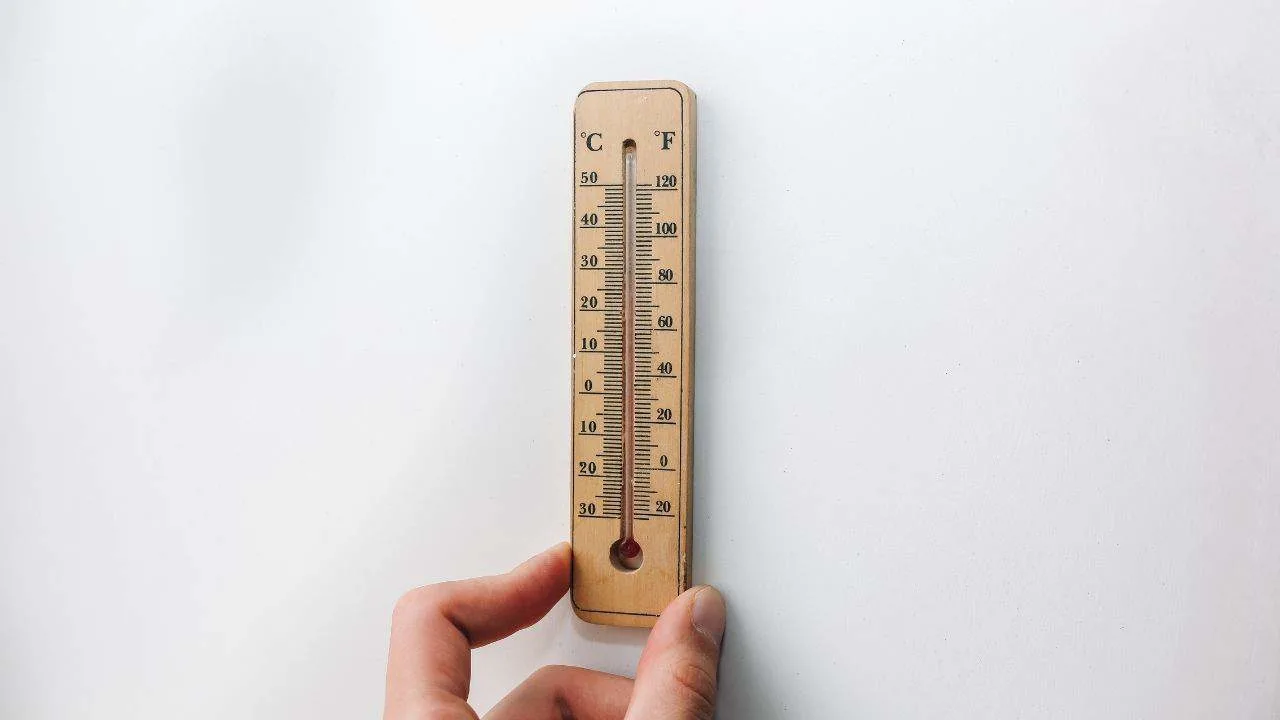
Carefully Monitoring Room Temperature for Burgundy Rubber Plant
If you are taking care of Burgundy Rubber Plant, controlling the temperature is what you need to put your best at.
This plant is extremely susceptible to changes in temperature and can not tolerate drastic temperature changes in times of relocation of the plant.
Always make sure that you adjust the plant temperature slowly and gradually. This process will take many days, a month at most, but it is only for the best growth of your plant.
If shifted to a colder environment suddenly, it will show signs of drooping leaves and stained ends.
The optimum temperature for a burgundy rubber plant is 65 Fahrenheit to 78 Fahrenheit (18 to 25 degrees Celsius).
6. Fertilizer
The Burgundy rubber plant does not need frequent fertilizing.
In fact, regular feeding should be avoided as fertilizing more than once a month can have adverse effects and lead to discolored leaves and attract certain insects, depending upon the type of fertilizer used.
However, for this plant, it is recommended to choose a water-soluble slow-release fertilizer that helps the plant’s optimum growth.
7. Pruning
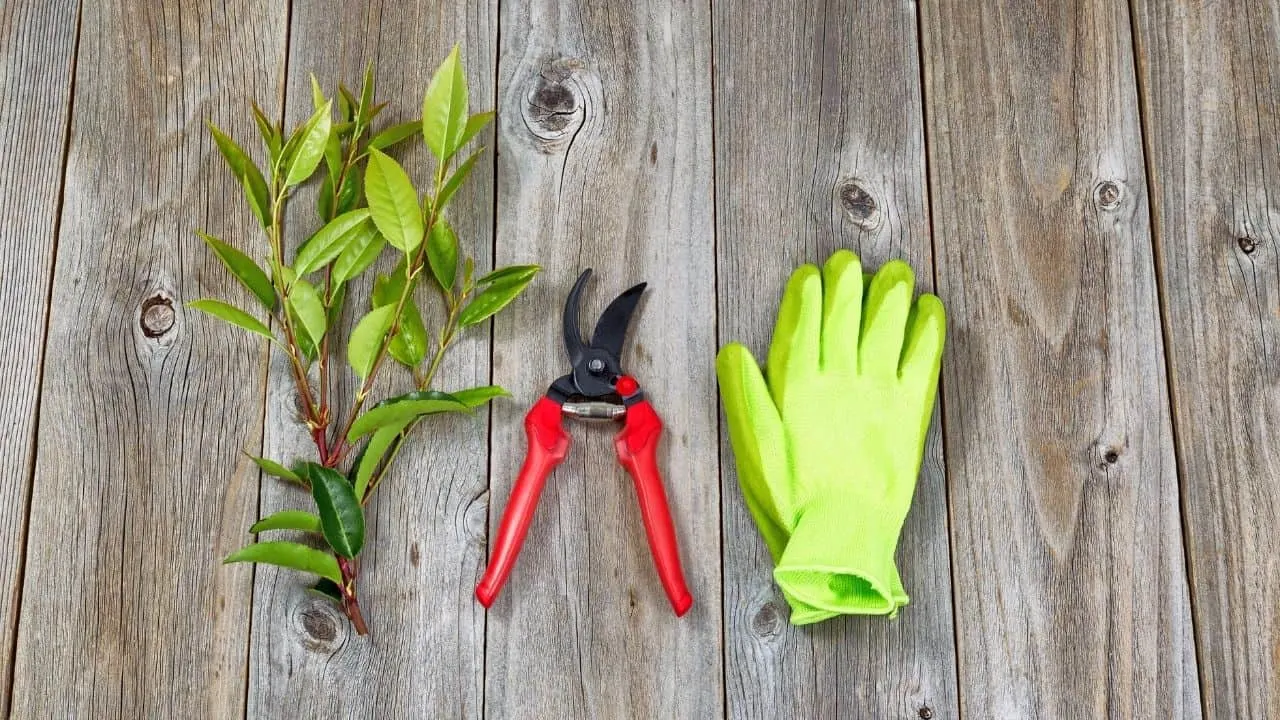
Pruning Burgundy Rubber Plants
Cutting the plant at regular intervals and adjusting its size helps the overall body of the plant to stay strong and develop more side shoots.
To prune the plant, choose a few stems that have become extremely tall and could use a nice cut, and gently wipe with a disinfectant.
Once you have cleaned the stems, cut the stems with a sharp object such as a knife or a secateur. As the few central stems of the plant become smaller, they develop the potential to regrow exponentially.
8. Repotting

Repotting Burgundy Rubber Plant
As this plant grows rapidly and can reach incredible heights very quickly, it is implied that it needs repotting every once in a while, preferably once in a year.
To repot, make sure that you use fresh potting mix so that the soil is new and carries the potential to support a newly repotted plant.
Since this plant has large leaves and the pot is relatively small, you can add a fine layer of small stones right at the bottom of the pot so that it acts as additional weight to support the plant.
As the leaves grow, this previously added layer of stones will help them to keep a fine balance and not tip over.
View this post on Instagram
Common Problems for Burgundy Rubber Plant
Yellow Leaves
The most common problem with burgundy rubber plants is that the leaves start to turn yellow. While this is a very prevalent issue in this plant, figuring out the true cause behind this is tricky.
Yellow leaves can occur in your plant for many reasons, such as moisture, humidity level, soil mixture, and pests, of course.
Soil moisture can significantly contribute to yellow leaves, which should otherwise be burgundy in color. Soil moisture’s referring to the water amount your plants hold in themselves when you water them.
To tackle this, you will need to adopt a strict watering routine so that you can accurately measure when your plant needs water and when it should be avoided.
Ensure the soil’s top 3 inches are dry. Moreover, make sure that water flows from the plant pot’s bottom drainage hole.
Once you see the water flowing, you can stop watering the plant as it means that the water has reached the entire soil surface.
The humidity level is another factor contributing to yellow leaves.
This is because of low humidity levels, in which this plant faces a shortage of enough moisture and, therefore, leads to discoloration of the leaves.
If humidity levels are not controlled for a long time, the plant may also be susceptible to death.
Moreover, if placed in a spot with harsh rays of sunlight, the beautiful burgundy color in your leaves will soon change to light green and, eventually, yellow.
To prevent this, placing the plant pot in a shade pot is recommended when enough indirect sunlight can reach the plant.
Keep in mind that the plant loves sunlight for longer periods, but it should always be indirect. Otherwise, the foliage is prone to burn and deteriorate.
Pests
Burgundy rubber plant, owing to its wonderful shaded colors, attracts a lot of insects and pests. If the plant has been weakened due to insufficient light or water, it will be more susceptible to plant diseases.
Some of the insects found on this plant are spider mites and mealybugs.
Thorough care should be taken when dealing with these plant insects. If witnessed early, they can be easily wiped off with a soft microfiber cloth dipped in detergent.
However, if the harmful insect has penetrated deep into the stem and roots of the plant, you will need to repot the plant immediately.
Is Black Prince and Burgundy Rubber Plant the same?
A Ficus Black Prince and a Burgundy Rubber Plant are the same. Yet annother name for Ficus elastica Burgundy is Ficus elastica Abidjan.
The Ficus elastica Burgundy has dark foliage that has a burgundy shine. The midribs are read as well as the new growth.
The leaves range from a dark black to burgundy to even green. If the leaves of a Burgundy Rubber Plant are mostly green it is getting insufficient light.
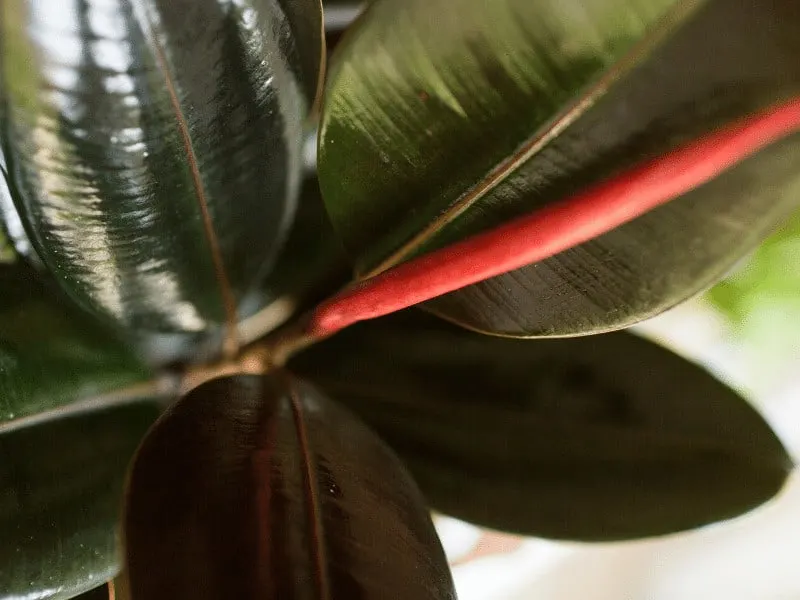
Ficus elastica Burgundy is the same as Ficus elastica Black Prince or Ficus elastica Abidjan
How often should I water my Burgundy Rubber Plant?
Make sure the soil can dry out between waterings and water once the top 2-3 inches of soil are dry (5-7.5cm). Generally a Burgundy Rubber Plant should be watered once every 2 weeks.
Is Burgundy Rubber Plant toxic to dogs?
The Burgundy Rubber Plant is toxic to dogs. Keep it away from your dog and make sure it is not ingested.
How to make a Burgundy Rubber Plant Bushy
To make a Burgundy Rubber Plant bushier the best way is to propagate it and to put the propagated cuttings back into the pot. The more plants that grow in one pot the bushier your Burgund Rubber Plant will get. In addition cuttings will increase the chance of your plant branching out.
Rubber Plants rarely branch out on their own. Therefore taking cuttings is the way to go.
Burgundy Rubber Plant Turning Green
A Burgundy Rubber Plant will turn green when it is not getting enough light. Increase the level of light to the plant to increase the burgundy color. A good placement is an eastern- or western-facing window. The ideal light level is bright indirect light.
In addition, provide a Burgundy plant with a temperature between 65-78 degrees Fahrenheit (18-26 degrees Celsius) as higher temperatures will also impact the variegation in a positive way.
Frequently Asked Questions About Burgundy Rubber Plant Care
How to tell if the plant needs more water or the water routine should be controlled?
Touch the leaves very gently and try to feel their texture on their hands. If the leaves come off in crumbs when you touch them slightly, this indicates that the plant needs a good water intake. If the soil is mushy and the leaves are soft and lumpy, this means that your plant is retaining water.
Should I cut my Burgundy Rubber plant’s yellow leaves?
Pruning the unwanted leaves can be an easy way to eliminate the discoloration and prevent the yellow leaves’ spreading.
Should I take any precautions when caring for burgundy rubber plants?
The leaves of these plants produce a thick white substance known as latex. Potential consequences of inhaling or ingesting may be food poisoning and diarrhea. Therefore, serious care should be taken if you’ve got pets or kids in your home, they’re the most vulnerable to getting hurt by this plant.
Is my rubber plant under-watered?
Your plant may be underwatered if the leaves break easily and feel crispy to the touch. Crisp leaves are a warning sign as your plant will soon shed off leaves after getting crispy leaves. It is better to cut these leaves and maintain the nutrients of your plant so that it gains strength.
If I decide to prune my plant, should I wear anything on my hands?
If you decide to prune your plant for obvious reasons, always consider wearing thick gardening gloves to avoid any unseen spikes in the plant. Moreover, you can also invest in a secateur if you are not comfortable using your hand to prune your plant.
Conclusion About Burgundy Rubber Plant Care
To care for a Burgundy Rubber Plant provide bright indirect sunlight and temperatures between 65-78°F (18-26°C). Water once the top 3-inches of soil are dry (7.5cm). Keep humidity around 50% and fertilize once a month. As a potting miy use a mix consisting of peat moss, perlite and pine bark.

Daniel has been a plant enthusiast for over 20 years. He owns hundreds of houseplants and prepares for the chili growing seasons yearly with great anticipation. His favorite plants are plant species in the Araceae family, such as Monstera, Philodendron, and Anthurium. He also loves gardening and is growing hot peppers, tomatoes, and many more vegetables.

